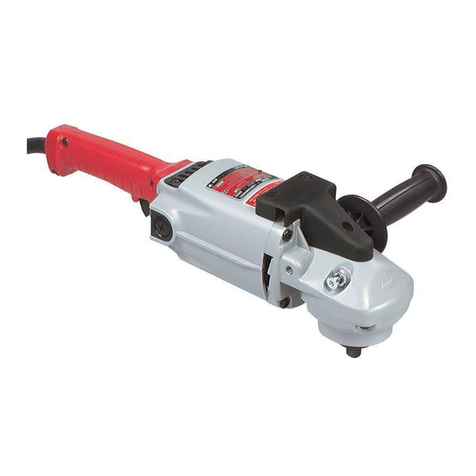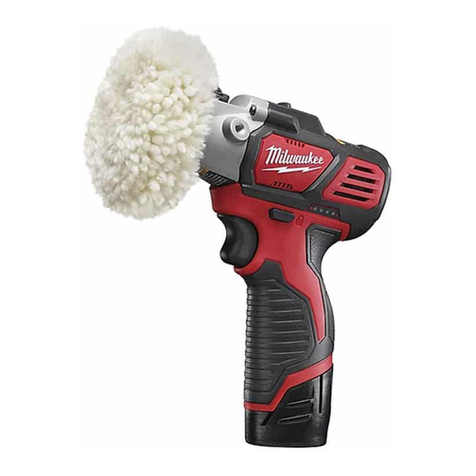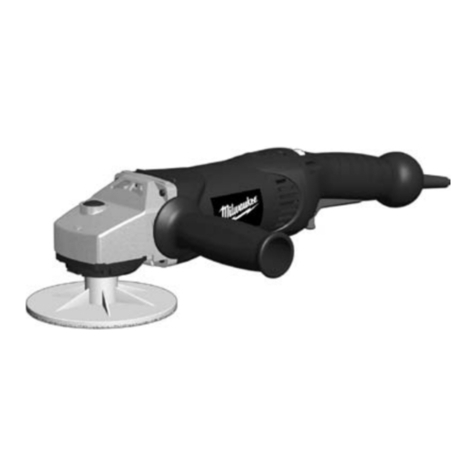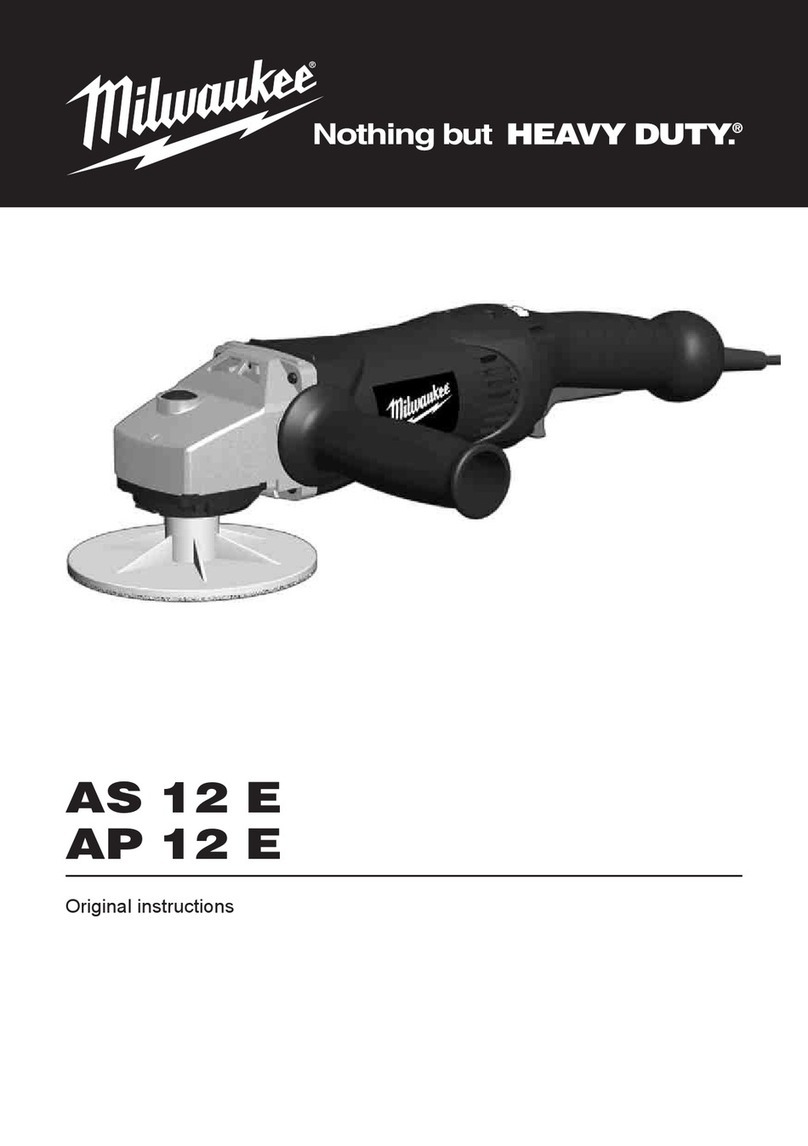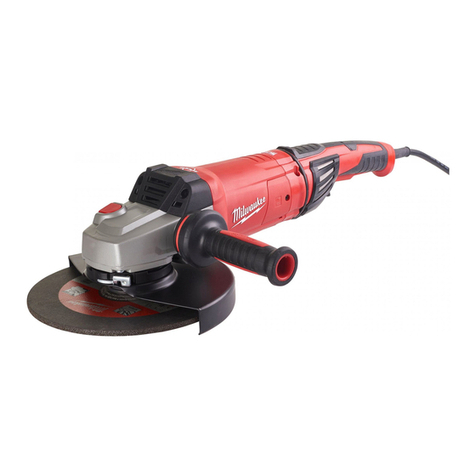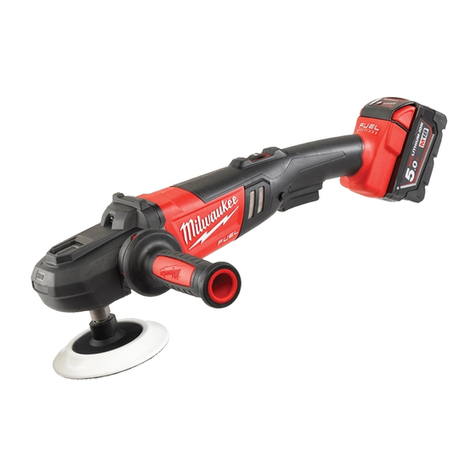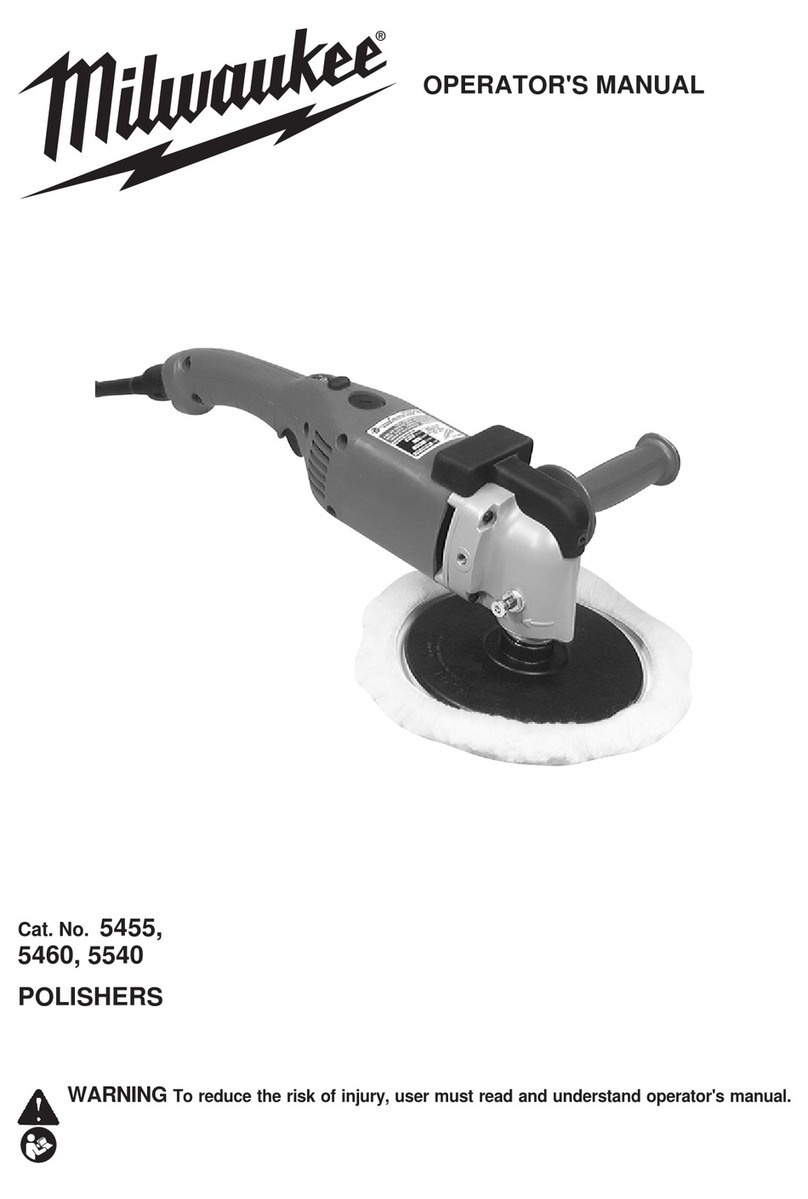23
PERSONAL SAFETY
GENERAL POWER TOOL SAFETY WARNINGS
WORK AREA SAFETY
ELECTRICAL SAFETY
•Keep work area clean and well lit. Cluttered or
dark areas invite accidents.
•Do notoperatepowertoolsinexplosiveatmos-
pheres, such as in the presence of flammable
liquids, gases or dust. Powertoolscreate sparks
which may ignite the dust or fumes.
•Keep children and bystanders away while
operating a power tool. Distractions can cause
you to lose control.
•Power tool plugs must match the outlet. Never
modify the plug in any way. Do not use any
adapter plugs with earthed (grounded) power
tools. Unmodified plugs and matching outlets will
reduce risk of electric shock.
•Avoid body contact with earthed or grounded
surfaces such as pipes, radiators, ranges and
refrigerators.Thereis an increased riskofelectric
shock if your body is earthed or grounded.
•Do notexposepower tools to rain orwet condi-
tions. Water entering a power tool will increase
the risk of electric shock.
•Do not abuse the cord. Never use the cord for
carrying, pulling or unplugging the power tool.
Keep cord away from heat, oil, sharp edges
or moving parts. Damaged or entangled cords
increase the risk of electric shock.
•When operating a power tool outdoors, use an
extension cord suitable for outdoor use. Use
of a cord suitable for outdoor use reduces the risk
of electric shock.
•If operating a power tool in a damp location
is unavoidable, use a residual current device
(RCD) protected supply. Useof an RCD reduces
the risk of electric shock.
attached to a rotating part of the power tool may
result in personal injury.
•Do not overreach. Keep proper footing and
balance at all times. This enables better control
of the power tool in unexpected situations.
•Dress properly. Do not wear loose clothing or
jewellery. Keep your hair, clothing and gloves
away from moving parts. Loose clothes, jewel-
lery or long hair can be caught in moving parts.
•If devices are provided for the connection of
dust extraction and collection facilities, ensure
these are connected and properly used. Use of
dust collection can reduce dust-related hazards.
WARNING READ ALL SAFETY WARNINGS AND ALL INSTRUCTIONS. Failure
to follow the warnings and instructions may result in electric shock, fire and/or serious
injury. Save all warnings and instructions for future reference. The term "power
tool" in the warnings refers to your mains-operated (corded) power tool or battery-operated
(cordless) power tool.
POWER TOOL USE AND CARE
•Do not force the power tool. Use the correct
power tool for your application. The correct
power tool will do the job better and safer at the
rate for which it was designed.
•Do notuse the power tool ifthe switch does not
turn it on and off. Any power tool that cannot be
controlled with the switch is dangerous and must
be repaired.
•Disconnect the plug from the power source
and/or the battery pack from the power tool
before making any adjustments, changing
accessories, or storing power tools. Such pre-
ventivesafetymeasuresreduce the risk of starting
the power tool accidentally.
•Store idle power tools out of the reach of chil-
dren and do not allow persons unfamiliar with
the power tool or these instructions to operate
the power tool. Powertools are dangerous in the
hands of untrained users.
•Maintain power tools. Check for misalignment
or binding of moving parts, breakage of parts
and any other condition that may affect the
power tool’s operation. If damaged, have the
power tool repaired before use. Manyaccidents
are caused by poorly maintained power tools.
•Keep cutting tools sharp and clean. Properly
maintained cutting tools with sharp cutting edges
are less likely to bind and are easier to control.
•Use the power tool, accessories and tool bits
etc., in accordance with these instructions,
takinginto account the working conditionsand
the work to be performed. Use of the power tool
for operations different from those intended could
result in a hazardous situation.
•Stay alert, watch what you are doing and use
common sensewhen operating apower tool.Do
not use apower tool whileyou aretired or under
the influence of drugs, alcohol or medication. A
moment of inattention while operating power tools
may result in serious personal injury.
•Use personal protective equipment. Always
wear eye protection. Protective equipment such
as dust mask, non-skid safety shoes, hard hat, or
hearingprotectionusedforappropriateconditions
will reduce personal injuries.
•Prevent unintentional starting. Ensure the
switch is in the off-position before connecting
to power source and/or battery pack, picking
up or carrying the tool. Carryingpowertools with
yourfingeronthe switch or energising power tools
that have the switch on invites accidents.
•Remove any adjusting key or wrench before
turning the power tool on. Awrench or a key left
SPECIFIC SAFETY RULES
SERVICE
•Have your power tool serviced by a qualified
repair person using only identical replacement
parts. Thiswillensurethatthesafetyof the power
tool is maintained.
•Holdpower tool by insulatedgripping surfaces,
because the belt may contact its own cord.
Cutting a “live” wire may make exposed metal
parts of the tool “live” and could give the operator
an electric shock.
•Maintain labels and nameplates. These carry
important information. If unreadable or missing,
contact a MILWAUKEE service facility for a free
replacement.
•WARNING : Somedustcreated by powersanding,
sawing, grinding, drilling, and other construction
activities contains chemicals known to cause
cancer, birth defects or other reproductive harm.
Some examples of these chemicals are:
• lead from lead-based paint
• crystalline silica from bricks and cement and
other masonry products, and
• arsenic and chromium from chemically-treated
lumber.
Your risk from these exposures varies, depending
on how often you do this type of work. To reduce
your exposure to these chemicals: work in a well
ventilated area, and work with approved safety
equipment,such as those dustmasksthatare spe-
cially designed to filter out microscopic particles.
FUNCTIONAL DESCRIPTION
SPECIFICATIONS
Cat.
No. Volts
AC Amps Orbits
Per Min. Paper
Size
6021-21 120 3 7000-12,000 5" dia.
1. Air vents
2. Handle
3. On/Off switch
4. Backing pad
5. Dust bag
6. Variable speed dial
Grounded tools require a three wire extension
cord. Double insulated tools can use either a two
or three wire extension cord. As the distance from
thesupplyoutletincreases, you must use a heavier
gauge extension cord. Using extension cords with
inadequately sized wire causes a serious drop in
voltage,resultinginlossofpowerandpossibletool
damage.Refertothetableshown to determine the
required minimum wire size.
The smaller the gauge number of the wire, the
greater the capacity of the cord. For example, a 14
gauge cord can carry a higher current than a 16
gauge cord. When using more than one extension
cord to make up the total length, be sure each cord
contains at least the minimum wire size required.
If you are using one extension cord for more than
one tool, add the nameplate amperes and use the
sum to determine the required minimum wire size.
Guidelines for Using Extension Cords
•If you are using an extension cord outdoors, be
sureitis marked withthesuffix“W-A”(“W”in Cana-
da)toindicatethatit is acceptable for outdoor use.
•Be sure your extension cord is properly wired
and in good electrical condition.Always replace a
damaged extension cord or have it repaired by a
qualified person before using it.
•Protect your extension cords from sharp objects,
excessive heat and damp or wet areas.
READ AND SAVE ALL
INSTRUCTIONS FOR FUTURE USE.
* Based on limiting the line voltage drop to five volts at
150% of the rated amperes.
EXTENSION CORDS
Double Insulated
Amps
Volts
Alternating Current Only
OPM Orbits Per Minute (OPM)
Underwriters Laboratories, Inc.
United States and Canada
SYMBOLOGY
Recommended Minimum Wire Gauge
For Extension Cords*
Extension Cord Length
Nameplate
Amperes 25' 50' 75' 100' 150'
0 - 2.0
2.1 - 3.4
3.5 - 5.0
5.1 - 7.0
7.1 - 12.0
12.1 - 16.0
16.1 - 20.0
18
18
18
18
16
14
12
18
18
18
16
14
12
10
18
18
16
14
12
10
18
16
14
12
10
16
14
12
12
1
3
4
2
5
6
